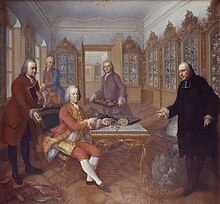Hof-Naturalien-Cabinet
The Hof-Naturalien-Cabinet or Hof-Naturalienkabinett was the predecessor of today's Natural History Museum in Vienna .
history
The Hof-Naturalien-Cabinet was a series of collections of various natural science subjects that were created or purchased under Emperor Franz Stephan von Lothringen , who is considered a patron of the sciences and the arts. The purchase of the collection from Johann Ritter von Baillou in 1748 is considered to be the founding date .
The focus of the collections was on minerals and fossils. The reason was that at this time living beings, due to the soft tissues, could not be properly prepared.
After Franz Stephan's death in 1765, the collections were taken over into state ownership and some of them were made accessible to the public. In 1776 Maria Theresa , who was mainly looking for the scientific basis for mining, appointed Ignaz von Born , a well-known geologist, to head the cabinets so that he could systematically expand them. Under Born, the collection achieved great importance in geological research for all of Europe.
Under Emperor Franz II , who was a well-known nature lover, the collection was expanded to include an animal cabinet. The basis of this collection goes back to Habsburg hunting trophies, some of which come from Maximilian II , but also collections from Johann Natterer .
At exhibitions around 1800 the animals were sometimes presented strictly, but sometimes only very little scientifically. The depiction of strangers, who were also depicted stuffed after their death, was also a curiosity. It is known Angelo Soliman whose skin was dissected after his death and was issued to the 1806th
In 1807 a separate plant cabinet was built. The basic stock comes from the emperor himself.
The natural history cabinets made significant progress under the scientist and organizer Karl von Schreibers , who directed them from 1806 to 1851. The individual departments were expanded into research facilities. Civil servants were employed, but these were often supported by volunteer work by well-known researchers and scientists in the cabinets. One example was Paul Partsch , who was mainly responsible for the minerals cabinet and also enriched it with his own collections. Personnel policy was also strongly influenced by arbitrary actions by Franz II's personal physician, Andreas Joseph von Stifft . This only changed after the death of Franz II, when Stifft lost his influence.
The cabinets suffered damage in the course of the October uprising in 1848, when parts of the collections were burned out or destroyed. This included, for example, numerous irretrievable pieces from the Brazil expedition .
In 1851, the cabinets were administratively divided into individual court cabinets, namely:
- Zoological court cabinet
- Botanical court cabinet
- Mineralogical court cabinet.
The collections have been continuously expanded. This happened through travelers or state expeditions, such as the Novara expedition , but also through the imperial family itself.
When they first began, the cabinets were housed in the Leopoldine wing of the Hofburg. The collection was later transferred to the Augustinergang, also in the Hofburg. The botanical cabinet was in the university . The increasing lack of space and the demolition of the city wall made it possible to build the Natural History Museum , which opened on August 10, 1889.
Web links
- Vienna researches (PDF file; 2.83 MB)
- The creation of the natural history cabinet
Individual evidence
- ^ Paul Partsch on the memorial (PDF; 5.1 MB) of January 15, 1957, accessed on April 4, 2009
- ↑ Annalen 1885 (PDF; 4.6 MB) of the Natural History Museum, accessed on April 6, 2009


